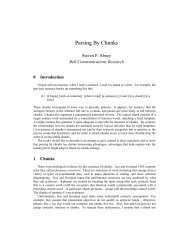The English Noun Phrase in its Sentential Aspect - Vinartus
The English Noun Phrase in its Sentential Aspect - Vinartus
The English Noun Phrase in its Sentential Aspect - Vinartus
Create successful ePaper yourself
Turn your PDF publications into a flip-book with our unique Google optimized e-Paper software.
<strong>The</strong> <strong>English</strong> <strong>Noun</strong> <strong>Phrase</strong>In Its <strong>Sentential</strong> <strong>Aspect</strong>bySteven Paul AbneySubmitted to the Department of L<strong>in</strong>guistics and Philosophy on8May1987, <strong>in</strong> partial fulllment of the requirements for the Degree of Doctor ofPhilosophy <strong>in</strong> L<strong>in</strong>guisticsABSTRACTThis dissertation is a defense of the hypothesis that the noun phrase isheaded by afunctional element (i.e., \non-lexical" category) D, identiedwith the determ<strong>in</strong>er. In this way, the structure of the noun phrase parallelsthat of the sentence, which is headed by In(ection), under assumptionsnow standard with<strong>in</strong> the Government-B<strong>in</strong>d<strong>in</strong>g (GB) framework.<strong>The</strong> central empirical problem addressed is the question of the properanalysis of the so-called \Poss-<strong>in</strong>g" gerund <strong>in</strong> <strong>English</strong>. This constructionpossesses simultaneously many properties of sentences, and many propertiesof noun phrases. <strong>The</strong> problem of captur<strong>in</strong>g this dual aspect of the Poss<strong>in</strong>gconstruction is heightened by current restrictive views of X-bar theory,which, <strong>in</strong> particular, rule out the obvious structure for Poss-<strong>in</strong>g, [ NP NPVP <strong>in</strong>g ], by virtue of <strong>its</strong> exocentricity.Consideration of languages <strong>in</strong> which nouns, even the most basic concretenouns, show agreement (AGR) with their possessors, po<strong>in</strong>ts to an analysisof the noun phrase as headed by an element similar to In, which provides aposition for AGR I call this In-like element \D". D and In belong to theclass of non-lexical categories, which I prefer to call functional categories.<strong>The</strong> analysis <strong>in</strong> which D heads the noun phrase I call the \DP-analysis".Import<strong>in</strong>g the DP-analysis <strong>in</strong>to <strong>English</strong> yields an immediate solution forthe problem of the Poss-<strong>in</strong>g gerund: Poss-<strong>in</strong>g gerunds (and by extension,noun phrases generally) have a more sentence-like structure than hithertothought, namely, [ DP DP's D VP <strong>in</strong>g ]. (In non-gerundive noun phrases,\VP" is replaced by a projection of N. This projection of N, despite be<strong>in</strong>ga maximal X-bar projection, corresponds to N-bar <strong>in</strong> the standard analysis.)Current trends <strong>in</strong> the treatment of m<strong>in</strong>or categories|so-called \nonlexical"categories|lead us to a similar conclusion. Until recently, m<strong>in</strong>orcategories like complementizers and modals had been treated as syncategorematic.Under current assumptions, however, they participate fully <strong>in</strong>the X-bar schema. Inthisway, two simplications are achieved simultaneously:we elim<strong>in</strong>ate syncategorematic elements, and we acquire an endo-



